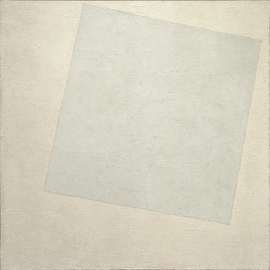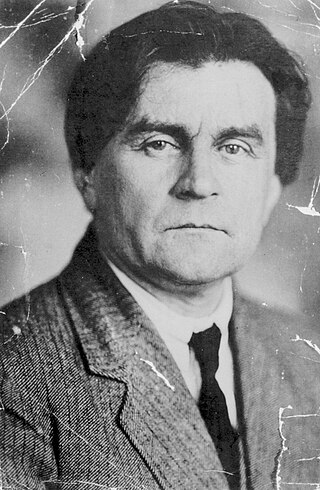
Kazimir Severinovich Malevich was a Ukrainian avant-garde artist and art theorist, whose pioneering work and writing influenced the development of abstract art in the 20th century. He was born in Kiev, to an ethnic Polish family. His concept of Suprematism sought to develop a form of expression that moved as far as possible from the world of natural forms (objectivity) and subject matter in order to access "the supremacy of pure feeling" and spirituality. Malevich is also sometimes considered to be part of the Ukrainian avant-garde that was shaped by Ukrainian-born artists who worked first in Ukraine and later over a geographical span between Europe and America.

Abstract art uses visual language of shape, form, color and line to create a composition which may exist with a degree of independence from visual references in the world.

Suprematism is an early twentieth-century art movement focused on the fundamentals of geometry, painted in a limited range of colors. The term suprematism refers to an abstract art based upon "the supremacy of pure artistic feeling" rather than on visual depiction of objects.

Monochromatic painting has played a significant role in modern and contemporary Western visual art, originating with the early 20th-century European avant-gardes. Artists have explored the non-representational potential of a single color, investigating shifts in value, diversity of texture, and formal nuances as a means of emotional expression, visual investigation into the inherent properties of painting, as well as a starting point for conceptual works. Ranging from geometric abstraction in a variety of mediums to non-representational gestural painting, monochromatic works continue to be an important influence in contemporary art.

Aleksandra Aleksandrovna Ekster, also known as Alexandra Exter, was a Russian and French painter and designer.

Lyubov Sergeyevna Popova was a Russian-Soviet avant-garde artist, painter and designer.
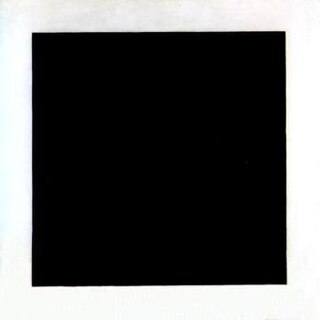
UNOVIS was a short-lived but influential group of artists, founded and led by Kazimir Malevich at the Vitebsk Art School in 1919.
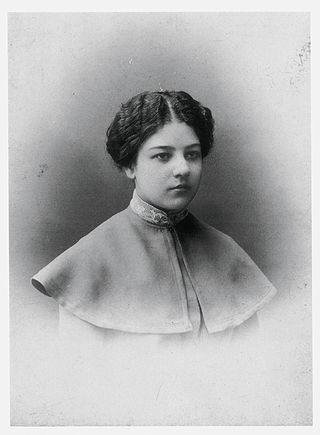
Olga Vladimirovna Rozanova was a Russian avant-garde artist painting in the styles of Suprematism, Neo-Primitivism, and Cubo-Futurism.
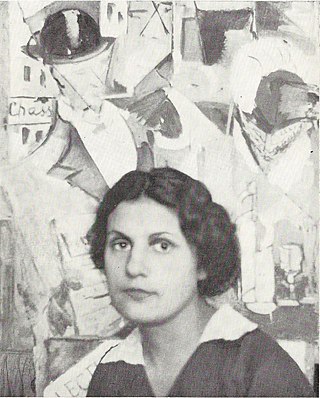
Nadezhda Andreevna Udaltsova was a Russian avant-garde artist, painter and teacher.
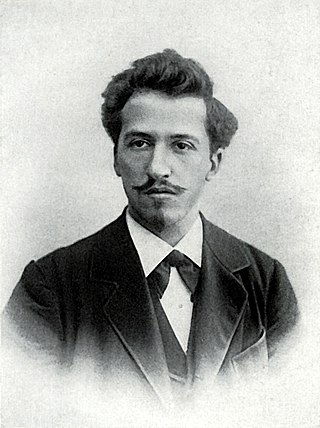
Pieter Cornelis Mondriaan, after 1906 known as Piet Mondrian, was a Dutch painter and art theoretician who is regarded as one of the greatest artists of the 20th century. He is known for being one of the pioneers of 20th-century abstract art, as he changed his artistic direction from figurative painting to an increasingly abstract style, until he reached a point where his artistic vocabulary was reduced to simple geometric elements.

Michael Vasilyevich Matyushin was a Russian painter and composer, leading member of the Russian avant-garde. In 1910–1913 Matyushin and his wife Elena Guro (1877–1913) were key members of the Union of the Youth, an association of Russian Futurists. Matyushin, a professional musician and amateur painter, studied physiology of human senses and developed his own concept of the fourth dimension connecting visual and musical arts, a theory that he put to practice in the classrooms of Leningrad Workshop of Vkhutein and INHUK (1918–1934) and summarized in his 1932 Reference of Colour. Matyushin conducted experiments at his Visiology Center (Zorved) to demonstrate that expanding visual sensitivity from retinian optical centers would enable the discovery of "new organic substance and rhythm in the apprehension of space." He tried to teach himself and his students to see with both eyes, each independently, and to widen the field of their vision. He describes some of his work and ideas in a long essay titled "An Artist's Experience of the New Space."
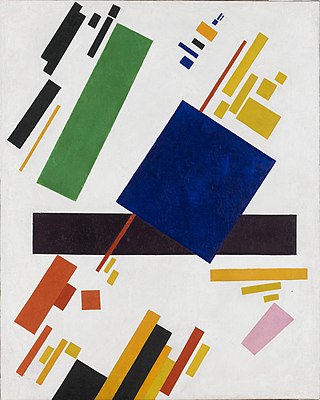
Suprematist Composition (blue rectangle over the red beam) is a 1916 painting by Kazimir Malevich, Russian painter of geometric abstraction.

Ilya Grigorevich Chashnik was a suprematist artist, a pupil of Kazimir Malevich and a founding member of the UNOVIS school.
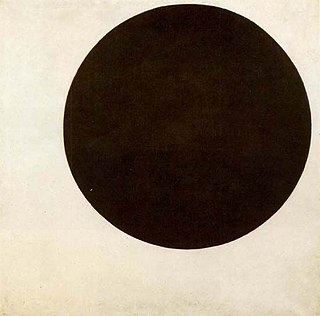
Black Circle is a 1924 oil on canvas painting by the Kiev-born Russian artist Kazimir Malevich, founder of the Russian Suprematism movement. From the mid-1910s, Malevich abandoned any trace of figurature or representation from his paintings in favour of pure abstraction.

The Last Futurist Exhibition of Paintings 0,10 was an exhibition presented by the Dobychina Art Bureau at Marsovo Pole, Petrograd, from 19 December 1915 to 17 January 1916. The exhibition was important in inaugurating a form of non-objective art called Suprematism, introducing a daring visual vernacular composed of geometric forms of varying colour, and in signifying the end of Russia's previous leading art movement, Cubo-Futurism, hence the exhibition's full name. The sort of geometric abstraction relating to Suprematism was distinct in the apparent kinetic motion and angular shapes of its elements.
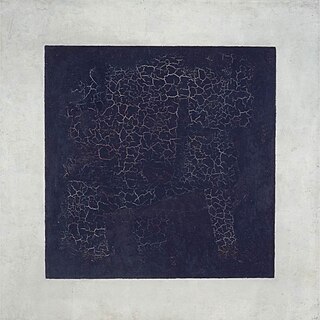
Black Square is an iconic 1915 painting by Kazimir Malevich. The first version was done in 1915. Malevich made four variants of which the last is thought to have been painted during the late 1920s or early 1930s. Black Square was first shown in The Last Futurist Exhibition 0,10 in 1915.
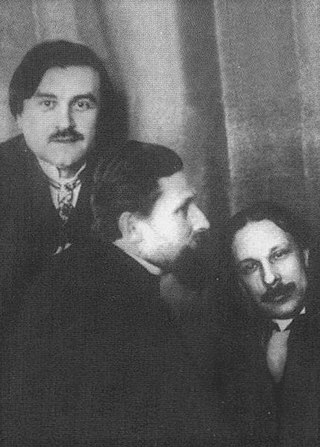
Aleksei Alekseevich Morgunov was a Russian Avant-Garde painter. His works were originally in the Neo-Primitivist style, but became influenced by Fauvism. Together with Kazimir Malevich and Ivan Kliun, he created a style known as "Februaryism". He later took up Neo-Classicism, then was forced to adopt the Socialist Realism model.

An Englishman in Moscow, is a 1914 oil on canvas painting by Russian avant-garde artist and art theorist Kazimir Malevich.
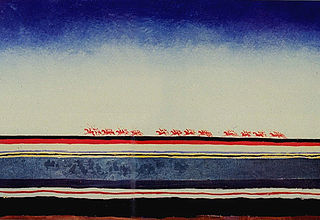
Red Cavalry is an oil on canvas painting of 1932 by the Russian avant-garde artist Kazimir Malevich. It depicts Red Cavalry horsemen racing across a plain, the ground beneath them illustrated with Suprematist stripings of color. It is considered Malevich's only contribution into the pantheon of Soviet art; Malevich intentionally dated the work to 1918, and added the blurb “From the capital of the October Revolution, the Red Cavalry rides to defend the Soviet frontier” on the back.

Auf Weiss II (Sur blanc II), in English: On White II, is an 1923 oil-on-canvas painting by Russian painter Wassily Kandinsky. It was created when the artist was a teacher at the Bauhaus in Weimar. The painting initially hung in the dining room of Wassily and Nina Kandinsky's apartment at Bauhaus Dessau. Since 1976, as a gift from Nina Kandinsky, it has been in the collection of the Musée National d'Art Moderne, in Paris.
